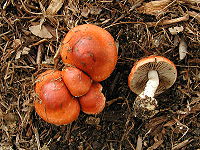- Leratiomyces ceres
-
Leratiomyces ceres 
Scientific classification Kingdom: Fungi Division: Basidiomycota Class: Agaricomycetes Order: Agaricales Family: Strophariaceae Genus: Leratiomyces Species: L. ceres Binomial name Leratiomyces ceres
(Cooke & Masee) Spooner & Bridge (2008)Synonyms Agaricus squamosus f. aurantiacus
Hypholoma aurantiaca
Hypholoma aurantiacum
Naematoloma aurantiaca
Naematoloma aurantiacum
Psilocybe aurantiaca
Psilocybe ceres
Stropharia aurantiaca
Stropharia percevalii var. aurantiaca
Stropharia squamosa var. aurantiaca
Stropholoma aurantiacumLeratiomyces ceres Mycological characteristics 
gills on hymenium 
cap is convex 
hymenium is adnate 
stipe has a ring 
spore print is brown 
ecology is saprotrophic 
edibility: poisonous Leratiomyces ceres[1], commonly known as the Redlead Roundhead, is mushroom which has a bright red to orange cap and dark purple-brown spore deposit. It is usually found growing gregariously on wood chips and is one of the most common and most distinctive mushrooms found in that habitat.[1][2] It is also known as Stropharia aurantiaca, Hypholoma aurantiaca, Naematoloma aurantiaca, and a number of other synonyms. It is common in wood chips and lawns in North America, Europe, Australia, New Zealand and elsewhere.[1]
Description
- Cap: 2 to 6 cm in diameter, with thin flesh and a bright red to brick red top which is convex to plane in age. Has partial veil remnants when young. The cap surface is usually dry, but can be slightly viscid when moist.
- Gills: Close, white to pale gray at first, later darker purple/brown or purplish grey with whitish edges. Attached (adnexed to adnate) and often notched.
- Spores: Dark purple/brown. 10-13.5 x 6-8.5 m. Elliptical and smooth.
- Stipe: Whitish, often with dark orange stains in age (most evident around base), 4-8 cm long, .5 to 1cm wide, equal to slightly larger at the base, which often has pale yellowish mycelium attached. The veil is thin and leaves a fragile ring, sometimes not present with age. The stalk is smooth above the ring and has tiny scales below, which often wash off in rain.
- Taste: Mild
- Odor: Mild
- Edibility: Poisonous
References
- ^ a b c Bridge PD, Spooner BM, Beever RE, Park DC. (2008). Taxonomy of the fungus commonly known as Stropharia aurantiaca, with new combinations in Leratiomyces. Mycotaxon 103:109–121.
- ^ Arora D. 1986. Mushrooms Demystified: A Comprehensive Guide to the Fleshy Fungi (2nd edition). Berkeley: Ten Speed Press. ISBN 0-89815-169-4.
External links
Categories:- Agaricales stubs
- Strophariaceae
- Fungi of Europe
- Fungi of North America
- Fungi native to Australia
Wikimedia Foundation. 2010.
